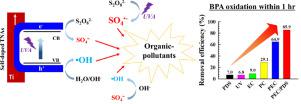Water Research ( IF 11.4 ) Pub Date : 2021-01-04 , DOI: 10.1016/j.watres.2021.116803 Aseom Son , Jiho Lee , Changha Lee , Kangwoo Cho , Jaesang Lee , Seok Won Hong

|
This study investigated the influence of adding peroxydisulfate (PDS) to a photoelectrocatalysis (PEC) system using self-doped TiO2 nanotube arrays (bl-TNAs) for organic pollutant degradation. The addition of 1.0 mM PDS increased the bisphenol-A (BPA) removal efficiency of PEC (PEC/PDS) from 65.0% to 85.9% within 1 h. The enhancement could be attributed to the high formation yield of hydroxyl radicals (·OH), increased charge separation, and assistance of the sulfate radicals (SO4·−). The PDS concentration and applied potential bias were influential operating parameters for the PEC/PDS system. In addition, the system exhibited a highly stable performance over a wide range of pH values and background inorganic and organic constituents, such as chloride ions, bicarbonate, and humic acid. Further, the degradation performance of the organic pollutant mixture, including BPA, 4-chlorophenol (4-CP), sulfamethoxazole (SMX), and carbamazepine (CBZ), was evaluated in 0.1 M (NH4)2SO4 solution and real surface water. The degradation efficiency increased in the order of CBZ < SMX < 4-CP < BPA in the PEC and PEC/PDS systems with both water matrices. Compared with the PEC system, the PEC/PDS (1.0 mM) system showed a threefold higher pseudo first-order reaction rate constant for BPA among pollutant mixtures in surface water. This was attributed to enhanced ·OH production and the selective nature of SO4·−. The pseudo first-order reaction rate constants of other pollutants, i.e., 4-CP, SMX, and CBZ increased ca. twofold in the PEC/PDS system. The results of this study showed that the PEC/PDS system with bl-TNAs is a viable technology for oxidative treatment.
中文翻译:

使用自掺杂TiO 2纳米管阵列的过硫酸盐增强的有机污染物的光电化学氧化:操作参数和水基质的影响
这项研究调查了添加过氧化二硫酸盐(PDS)到使用自掺杂TiO 2纳米管阵列(bl-TNA)的光电催化(PEC)系统中有机污染物降解的影响。1.0 mM PDS的添加在1小时内将PEC(PEC / PDS)的双酚A(BPA)去除效率从65.0%提高到85.9%。增强可以归因于羟基自由基(· OH)的高形成产率,增加的电荷分离以及硫酸根自由基(SO 4 ·-)。PDS浓度和施加的电势偏差是PEC / PDS系统的有影响的运行参数。此外,该系统在很宽的pH值范围和背景无机和有机成分(例如氯离子,碳酸氢根和腐殖酸)中均表现出高度稳定的性能。此外,在0.1 M(NH 4)2 SO 4中评估了BPA,4-氯苯酚(4-CP),磺胺甲恶唑(SMX)和卡马西平(CBZ)等有机污染物混合物的降解性能。溶液和地表水。在两种水基的PEC和PEC / PDS系统中,降解效率按CBZ <SMX <4-CP <BPA的顺序增加。与PEC系统相比,PEC / PDS(1.0 mM)系统在地表水中污染物混合物中对BPA的假一级反应速率常数高出三倍。这归因于· OH产量增加和SO 4 ·−的选择性。其他污染物(即4-CP,SMX和CBZ)的伪一级反应速率常数约增加。在PEC / PDS系统中是双重的。这项研究的结果表明,带有bl-TNA的PEC / PDS系统是一种可行的氧化处理技术。











































 京公网安备 11010802027423号
京公网安备 11010802027423号